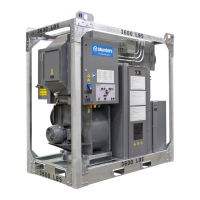Manual# I27028 3-2 Rev. 2 – 11/22/2017
Figure 3-2
COMPLETE OPERATING UNIT
Figure 3-1 and Figure 3-2 show that, at one moment, the wheel is being used to pick up
moisture, and a moment later, the wheel is being heated to drive off the moisture. In
the R-Series unit, both actions are happening at the same time, on different sections of
the wheel. All sections of the wheel go through the following cyclic process:
• At the beginning of the process, this section of the wheel is exposed to the damp
“process” air.
• As the wheel turns, this section of the wheel moves under the stream of heated
“reactivation” air. This part of the wheel is then dried out by the heated air.
• Finally, the dried part of the wheel turns into the “process” area again so it can pick
up more moisture.
During this cycle, the wheel does not stop. One side of the wheel is picking up moisture
while the other side is being dried out. The wheel rotates quite slowly – 8 revolutions
per hour.
The HoneyCombe
®
wheel has been carefully designed. The honeycomb material is non-
metallic and does not react to bacteria. The desiccant material used in this model is
shown in the following table:
Desiccant Type
Color
Marking
Titanium enhanced silica gel Red Tigel
A wheel using titanium enhanced silica gel depends on the “adsorption” principle. Each
particle of chemical can bond with a large number of water molecules. Each water molecule is
attracted to many sites on the outside of the silica gel molecule. The process can be reversed
within the wheel by adding heat. As the desiccant is heated, it releases water to the air.
air
(dry
Process
sector of
wheel
air
Bypass damper
R15 onl
Reactivation
sector of wheel
Drive
Moto
Additional
filte
Reactivation
Blowe
Reactivation
air outlet
(moist)
Reactivation
Heate
Filter
Reactivation
air inlet
outside air
Blower
Desiccant
wheel

